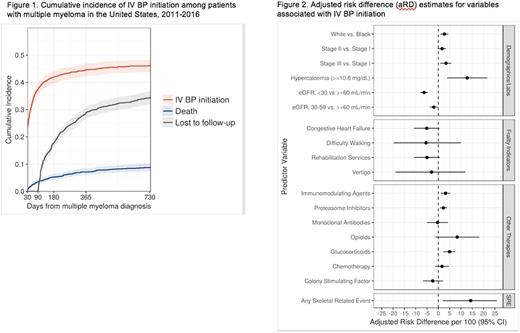Abstract

Introduction:Osteolytic lesions are detected in approximately 90% of patients with multiple myeloma (MM) and increase the risk of skeletal related events (SREs), including fractures and other bone complications. Intravenous bisphosphonates (IV BPs) are recommended for patients diagnosed with MM with or without detectable osteolytic lesions to prevent SREs and possibly slow the progression of myeloma. There are limited data available describing the use of IV BPs in this population. We examined the cumulative incidence of IV BP initiation, accounting for the competing risk of death, and assessed predictors of initiation, overall and by IV BP type.
Methods: An overall cohort of patients was identified using a sample of electronic health records from oncology clinics across the United States (Flatiron Health, Inc.) that linked to the MarketScan® employer-based and Medicare Supplemental administrative health insurance claims databases (Truven Health Analytics, Inc.) at any point before the MM diagnosis. Patients were aged 18 years or older and had a new MM diagnosis (ICD9, 203.00; ICD10, C90.00) between January 1, 2011 and April 30, 2016. Patients were excluded if they had an IV BP administration in the six months prior to the MM diagnosis, concurrent cancer in the 12 months prior to diagnosis, or did not have a healthcare encounter in the 30 days following the diagnosis. The cumulative incidence of IV BP initiation was estimated using competing risk models to account for death. To estimate predictors of initiation, we created a subcohort of patients who were additionally required to have continuous enrollment in MarketScan in the six months before the MM diagnosis. A multivariable generalized linear model was fit to estimate risk differences for predictors of initiation, and 95% confidence intervals (CIs) were obtained by a parametric bootstrap. Laboratory results, comorbidities, other therapies and SREs were included as time-varying variables in the model.
Results: Among the 1875 patients in the overall cohort with a MM diagnosis, 60% were 65 years and older, 65% were white, and 13% had stage III MM at diagnosis. These characteristics were similar for the subcohort (N = 758). The cumulative incidence of IV BP initiation was 24% (95% CI: 22, 26%) at 30 days, 38% (35, 40%) at 90 days, and 44% (42, 46%) at 1 year. The cumulative incidence of treatment initiation was similar for patients diagnosed with MM in all calendar years of the study, but was higher for patients receiving anti-myeloma therapies. Zoledronic acid was the most commonly initiated IV BP; among those treated with an IV BP, 93% were administered zoledronic acid while only 7% were administered pamidronate. In the multivariate model, whites (compared with Blacks), patients with Stage III MM at diagnosis (compared to Stage I), patients with hypercalcemia, and patients undergoing other treatments (some anti-myeloma therapies, opioids, and glucocorticoids) were more likely to initiate an IV BP. Experiencing an SRE was the strongest predictor of IV BP initiation. Patients who had an SRE were more likely to initiate zoledronic acid, but less likely to initiate pamidronate. Patients with severely impaired renal function, defined as eGFR <30 mL/min, or patients with indicators of frailty were less likely to initiate an IV BP.
Conclusions: In this study of patients diagnosed with MM who had employer-based commercial insurance or Medicare Supplemental coverage, the incidence of IV BP administration was lower than expected. Less than half of patients initiated an IV BP in the two years after diagnosis, indicating that a considerable number of patients with MM may be at increased risk for experiencing a bone complication. There are clinical reasons why patients may go untreated such as frailty or severely impaired renal function. Taking these patient characteristics into account, these real-world data revealed that an SRE was the strongest predictor of IV BP initiation, underscoring the need to manage the bone health of patients with MM more proactively.
Hernandez: Amgen Inc.: Employment, Equity Ownership. Liede: Amgen Inc.: Employment, Equity Ownership. Brookhart: Amgen Inc.: Other: Scientific advisor, Research Funding; AstraZeneca: Research Funding; Merck: Other: Scientific advisor; GSK: Other: Scientific advisor; UCB: Other: Scientific advisor; Genentech: Other: Scientific advisor; TargetPharma: Other: Scientific advisor; RxAnte: Other: Scientific advisor.
Author notes
Asterisk with author names denotes non-ASH members.

This icon denotes a clinically relevant abstract


This feature is available to Subscribers Only
Sign In or Create an Account Close Modal